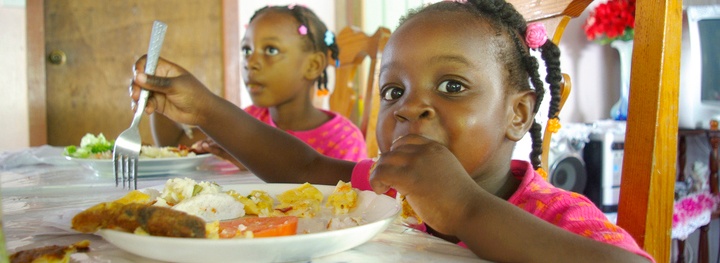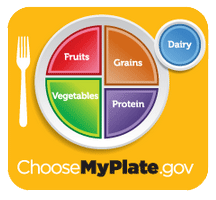Understanding portion sizes
You have probably read that portion sizes have increased over the last few decades. You may also know that Americans’ prevalence of overweight and obesity has also increased over the same amount of time. Decreasing portion size is one of the simplest ways to reduce caloric intake and avoid overeating.

Appropriate portion sizes change as we grow, so adult portions aren’t appropriate for children’s bodies. Here is an excellent guide to establishing how much of what should be eaten at each age. As always, following the MyPlate guide, ensuring that at least half of every meal is composed of fruits and vegetables, and practicing 5-2-1-0 every day, are best practices everyone in your family can follow.

Eating out at restaurants, or carrying out (at least right now) can come with its own set of pitfalls – portion sizes are notoriously larger in restaurants than you might serve yourself at home. But “one serving” sends a message that the whole thing is appropriate for one person, even when in reality it’s more like two or three servings. It’s important to learn what a portion size looks like, even in a restaurant, so you don’t overdo it. There are several tools you can employ to ensure you stick to eating one portion. Sending part of your meal to be packed up for leftovers at the very start of eating is always an option. And who doesn’t love leftovers? Sharing your plate with another person is another. Even ordering off of the appetizer menu for your entree (often some of the best selections, and usually cheaper than entrees to boot) can be another way. When you are very hungry and confronted with all kinds of good-sounding food, judgement can go out the window, so make a plan before you go. Look at the menu online ahead of time to get an idea of what looks healthy and what you’ll want to order, and stick to your plan.

Getting plenty of fruits and vegetables is an important part of building your meals. Use this handy 5-2-1-0 tracker to track your five daily servings of fruits and vegetables (as well as your two hours of recreational screen time, one hour of physical activity and zero sugary drinks each day).
Educate children early to understand portions
Child care best practices include serving meals family style. One of the benefits of eating meals family-style is that by serving from one dish, young children learn the appropriate portion size to serve themselves and eat. In following best practices in child care environments, the rule goes that the correct portion be served to a child to start. If he or she is hungry after finishing that size, they can have more, but it’s important to learn the correct size from the start. Certain meals are also served in ready-sized portions. Here is a great tool from CACFP about creating meals at the right size for young children – use muffin tins! Go here for some helpful recipes.

Mini Workout of the Week: Hyvee Kids Fit
We came across this terrific website with many physical activity videos for kids and the whole family. Take a look – they have videos for every day of the week. Today we are featuring: Just Legs Tabata
Topics: 5210, Healthy Eating
Subscribe for more
Want more ideas for healthy schools, workplaces, child care providers, and families? Subscribe to our blog for weekly tips delivered right to your inbox!
Keeping kids active and more quarantine resources NEXT »
Wellness in Schools, part 1: what that looks like at school
